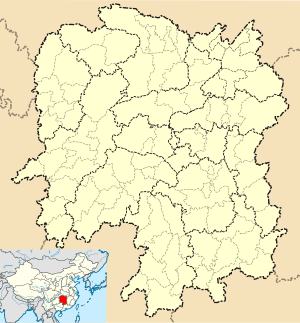Pingjiang County
| Pingjiang County 平江县 | |
|---|---|
| County | |
 Pingjiang Location of the seat in Hunan | |
| Coordinates: 28°42′07″N 113°34′52″E / 28.702°N 113.581°ECoordinates: 28°42′07″N 113°34′52″E / 28.702°N 113.581°E | |
| Country | People's Republic of China |
| Province | Hunan |
| Prefecture-level city | Yueyang |
| Time zone | UTC+8 (China Standard) |
Pingjiang County (simplified Chinese: 平江县; traditional Chinese: 平江縣; pinyin: Píngjiāng Xiàn) is a county in the northeast of Hunan province, China. It is the easternmost county-level division of the prefecture-level city of Yueyang.
The county is located on the eastern margin of the province, the Miluo River runs through the county from east to west. It is bordered to the north by Yueyang County, to the west by Miluo City, to the south by Changsha County and Liuyang City, to the east by Xiushui and Tonggu Counties of Jiangxi, to the northeast by Tongcheng County of Hubei.[1]
Pingjiang County covers an area of 4,114 km2 (1,588 sq mi), as of 2015, it had a registered population of 1,106,900 and a permanent resident population of 979,300. The county has 19 towns and 5 townships under its jurisdiction. The government seat is Hanchang Town (汉昌镇).[2]
History
In the Chinese Civil War, Pingjiang was a part of the Hunan-Hubei-Jiangxi Revolutionary Base Area (湘鄂赣革命根据地), and, from 1931 November, of the Hunan-Hubei-Jiangxi Soviet (湘鄂赣苏维埃).
The Communist Marshal Peng Dehuai was a Kuomintang Colonel in 1928, when he was stationed in Pingjiang with orders to eliminate local groups of communist guerrillas who had fled to the area following Chiang Kai-shek's nationwide suppression of Communists. Because Peng had secretly joined the Chinese Communist Party he instead kept his unit passive and began to organize local Communist Party branches. Peng rebelled against the Kuomintang on 28 July 1928, beginning his career as a military leader in the Red Army from his base in Pingjiang. Some of Peng's subordinates in the rebellion survived and became important military figures themselves, including generals Huang Kecheng and Peng Shaohui.[3]
Administrative divisions
According to the result on adjustment of township-level administrative divisions of Pingjiang County on 24 November 2015, Pingjiang has 5 townships and 19 towns under its jurisdiction,[4] they are:
- Banjiang (板江乡)
- Dazhou, Pingjiang (大洲乡)
- Mujin, Pingjiang (木金乡)
- Sandun (三墩乡)
- Sanyang (三阳乡)
- 19 towns
- Anding, Pingjiang (安定镇)
- Cenchuan (岑川镇)
- Changshou, Pingjiang (长寿镇)
- Fushoushan (福寿山镇)
- Hanchang Town (汉昌镇)
- Hongqiao, Pingjiang (虹桥镇)
- Jiayi, Pingjiang (加义镇)
- Longmen, Pingjiang (龙门镇)
- Meixian, Pingjiang (梅仙镇)
- Nanjiang, Pingjiang (南江镇)
- Sanshi (三市镇)
- Shangtashi (上塔市镇)
- Tongshi (童市镇)
- Wengjiang (瓮江镇)
- Wukou (浯口镇)
- Wushi, Pingjiang (伍市镇)
- Xiangjia (向家镇)
- Niushizhai (石牛寨镇)
- Yuping, Pingjiang (余坪镇)
Climate
| Climate data for Pingjiang (1981−2010) | |||||||||||||
|---|---|---|---|---|---|---|---|---|---|---|---|---|---|
| Month | Jan | Feb | Mar | Apr | May | Jun | Jul | Aug | Sep | Oct | Nov | Dec | Year |
| Record high °C (°F) | 24.2 (75.6) |
29.5 (85.1) |
32.6 (90.7) |
35.0 (95) |
35.8 (96.4) |
38.4 (101.1) |
40.0 (104) |
40.8 (105.4) |
38.5 (101.3) |
35.1 (95.2) |
32.2 (90) |
24.0 (75.2) |
40.8 (105.4) |
| Average high °C (°F) | 9.2 (48.6) |
11.7 (53.1) |
15.7 (60.3) |
22.5 (72.5) |
27.4 (81.3) |
30.3 (86.5) |
33.6 (92.5) |
33.2 (91.8) |
29.3 (84.7) |
24. (75) |
18.2 (64.8) |
12.4 (54.3) |
22.3 (72.1) |
| Daily mean °C (°F) | 4.7 (40.5) |
7.1 (44.8) |
10.9 (51.6) |
17.0 (62.6) |
21.9 (71.4) |
25.2 (77.4) |
28.4 (83.1) |
27.6 (81.7) |
23.6 (74.5) |
18.2 (64.8) |
12.2 (54) |
6.7 (44.1) |
17 (62.5) |
| Average low °C (°F) | 1.7 (35.1) |
3.9 (39) |
7.3 (45.1) |
13.1 (55.6) |
17.7 (63.9) |
21.6 (70.9) |
24.3 (75.7) |
23.7 (74.7) |
19.7 (67.5) |
14.2 (57.6) |
8.1 (46.6) |
2.9 (37.2) |
13.2 (55.7) |
| Record low °C (°F) | −7.1 (19.2) |
−6.4 (20.5) |
−4.6 (23.7) |
0.0 (32) |
7.9 (46.2) |
13.0 (55.4) |
17.1 (62.8) |
17.4 (63.3) |
9.5 (49.1) |
1.2 (34.2) |
−3.1 (26.4) |
−9.4 (15.1) |
−9.4 (15.1) |
| Average precipitation mm (inches) | 73.6 (2.898) |
90.8 (3.575) |
142.3 (5.602) |
193.0 (7.598) |
192.4 (7.575) |
245.6 (9.669) |
178.1 (7.012) |
136.6 (5.378) |
77.2 (3.039) |
71.1 (2.799) |
79.6 (3.134) |
44.5 (1.752) |
1,524.8 (60.031) |
| Average relative humidity (%) | 82 | 81 | 82 | 81 | 80 | 82 | 78 | 80 | 80 | 79 | 79 | 78 | 80 |
| Source: China Meteorological Data Service Center | |||||||||||||
Notes and references
- ↑ About Pingjiang County / 平江县 hnpj.ccoo.cn
- ↑ 平江县概况. xzqh.org. 2016-02-04.
- ↑ Domes, Jurgen. Peng Te-huai: The Man and the Image, London: C. Hurst & Company. 1985. ISBN 0-905838-99-8. pp.17-20, 49
- ↑ According to the result on adjustment of township-level administrative divisions of Pingjiang County on 24 November 2015: rednet (2015-12-04): 《湖南省民政厅关于同意平江县乡镇区划调整方案的批复》(湘民行发〔2015〕72号), also see hunan.gov (2015-12-07): 《湖南省乡镇区划调整方案公布 岳阳9县市区乡镇区划均有调整》